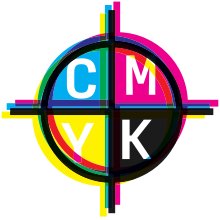Register (pressure)
With registration is in the printer language superimposing Adjust the individual colors in multicolor printing referred. Other terms that deal with the same problem, are color register , register difference or misregistration . In all printing processes, the register designates the correct printing with several successive printing passes. With four-color printing , the four process colors cyan , magenta , yellow and black are printed exactly one above the other and result in the final print image. If these four colors are not exactly in the right position with one another, the printed image appears blurred, blurred or with color shifts and has a negative effect on quality.
Cause of misregistration
In a sheet-fed printing press, registration errors can arise due to inaccurate application of the sheet to the feeder . With several printing passes, this means that the sheet runs differently through the printing machine each time and the print image of the individual colors is no longer exactly on top of one another. In most cases, the error can be remedied by setting the investor correctly.
During the production run of the machine can also register problems occur due to changes in operating speeds. Modern printing machines therefore offer the option of compensating for register differences during production using input commands. The behavior of the printing paper can also change during the printing process, for example through paper roll winding or paper storage conditions and the like. The monitoring printer can correct the error by correcting the machine settings in good time.
Problem solving
In today's web presses , an automatic register control, the so-called inline color register measurement , is used. Two register sensors measure the marks printed on both sides of the web at full production speed. If they are no longer exactly one above the other, the printing units are automatically corrected. Even modern newspaper presses are now working with automated register controls. There used to be the problem that the brands were too big. Since the finished product is not trimmed in newspaper printing, the marks were within the printed image and could be seen by the reader. In the meantime, however, the marks with a diameter of around one millimeter are very small and are hardly noticed.
See also
Individual evidence
- ↑ Helmut Kipphan (Hrsg.): Handbuch der Printmedien: Technologie und Produktionsverfahren, p. 331f. Springer-Verlag, Berlin, November 2000. ISBN 3-540-66941-8
literature
- Gutenberg Museum Mainz (Ed.): From Gutenberg to WorldWideWeb . Dachs Verlag, Vienna 2002.
- Helmut Hiller, Stephan Füssel: Dictionary of the book . 6th edition, Vittorio Klostermann Verlag, Frankfurt am Main 2002. ISBN 3-465-03495-3 .
- Helmut Kipphan (Hrsg.): Handbook of Print Media: Technologies and Production Processes. Springer-Verlag, Berlin November 2000, ISBN 3-540-66941-8 .
